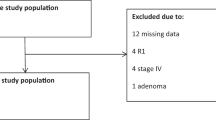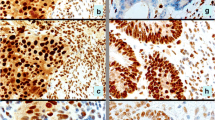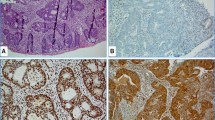Abstract
PURPOSE: Many studies have demonstrated that sporadic microsatellite instability–positive colorectal cancers share several clinicopathologic features with hereditary nonpolyposis colorectal cancers, including right-sided location, young age of onset, characteristic histomorphologic features, and a good prognosis. The aim of this study was to define distinct clinicopathologic features of sporadic microsatellite instability–positive colorectal cancers and to compare genotypic characteristics between microsatellite instability–positive and microsatellite instability–negative colorectal cancers in a young group. METHODS: We analyzed 61 cases of young patients (<40 years old) with colorectal cancers for microsatellite instability at five mononucleotide and three dinucleotide repeats, loss of heterozygosity at APC and DCC, and K-ras and p53 mutations. Microsatellite instability status was correlated with molecular genetic factors and clinicopathologic parameters. RESULTS: Microsatellite instability positivity was detected in 19 (31.1 percent) of 61 cases. Allelic alterations in TGFβRII, BAX, and IGFIIR were observed exclusively in microsatellite instability–positive tumors (63.1, 26.3, and 26.3 percent, respectively). Microsatellite instability–positive tumors exhibited a lower frequency of the p53 mutation (10.5 percent) than microsatellite instability–negative tumors (47.6 percent; P < 0.05). However, microsatellite instability status was not associated with APC or DCC allelic deletion or with the K-ras mutation. Microsatellite instability–positive colorectal cancers exhibited a proclivity toward proximal location, expansive growth pattern, and large tumor size (P < 0.05). Microsatellite instability–positive colorectal cancers had lower preoperative serum carcinoembryonic antigen levels (P < 0.05), a less advanced stage at presentation (P < 0.05), and a tendency toward better prognosis (P = 0.051) than microsatellite instability–negative colorectal cancers. However, there was no difference between microsatellite instability–positive and microsatellite instability–negative colorectal cancers regarding gross features, tumor grade, and extracellular mucin production. CONCLUSION: These results suggest that sporadic microsatellite instability–positive colorectal cancers in young patients have different histomorphologic features from microsatellite instability–negative colorectal cancers and hereditary nonpolyposis colorectal cancers, some overlap of genetic alterations on multistep carcinogenesis with microsatellite instability–negative colorectal cancers, and a tendency for better prognosis.
Similar content being viewed by others
References
H Kim J Jen B Vogelstein SR Hamilton (1994) ArticleTitleClinical and pathological characteristics of sporadic colorectal carcinomas with DNA replication errors in microsatellite sequences Am J Pathol 145 148–156
LA Aaltonen R Salovaara P Kristo et al. (1998) ArticleTitleIncidence of hereditary nonpolyposis colorectal cancer and the feasibility of molecular screening for the disease N Engl J Med 338 1481–1487
HT Lynch TC Smyrk P Watson et al. (1993) ArticleTitleGenetics, natural history, tumor spectrum, and pathology of hereditary nonpolyposis colorectal cancer Gastroenterology 104 1535–1549
RA Lothe P Peltomaki GI Meling et al. (1993) ArticleTitleGenomic instability in colorectal cancer Cancer Res 53 5849–5852
JM Cunningham ER Christensen DJ Tester et al. (1998) ArticleTitleHypermethylation of the hMLH1 promoter in colon cancer with microsatellite instability Cancer Res 58 3455–3460
JG Herman A Umar K Polyak et al. (1998) ArticleTitleIncidence and functional consequences of hMLH1 promoter hypermethylation in colorectal carcinoma Proc Natl Acad Sci U S A 95 6870–6875
KW Kinzler B Vogelstein (1996) ArticleTitleLessons from hereditary colorectal cancer Cell 87 159–170
T Fujiwara JM Stolker T Watanabe et al. (1998) ArticleTitleAccumulated clonal genetic alterations in familial and sporadic colorectal carcinomas with widespread instability in microsatellite sequences Am J Pathol 153 1063–1078
SN Thibodeau AJ French JM Cunningham et al. (1998) ArticleTitleMicrosatellite instability in colorectal cancer Cancer Res 58 1713–1718
WS Samowitz ML Slattery (1997) ArticleTitleMicrosatellite instability in colorectal adenomas Gastroenterology 112 1515–1519
M Konishi R Kikuchi-Yanoshita K Tanaka et al. (1996) ArticleTitleMolecular nature of colon tumors in hereditary nonpolyposis colon cancer, familial polyposis, and sporadic colon cancer Gastroenterology 111 307–317
WS Samowitz ML Slattery RA Kerber (1995) ArticleTitleMicrosatellite instability in human colonic cancer is not a useful clinical indicator of familial colorectal cancer Gastroenterology 109 1765–1771
JC Cusack GG Giacco K Cleary et al. (1996) ArticleTitleSurvival factors in 186 patients younger than 40 years old with colorectal adenocarcinoma J Am Coll Surg 183 105–112
JG Guillem J Puig-La Calle SuffixJr C Cellini et al. (1999) ArticleTitleVarying features of early age-of-onset “sporadic” and hereditary nonpolyposis colorectal cancer patients Dis Colon Rectum 42 36–42
R Gryfe H Kim ET Hsieh et al. (2000) ArticleTitleTumor microsatellite instability and clinical outcome in young patients with colorectal cancer N Engl J Med 342 69–77
HF Vasen JP Mecklin PM Khan HT Lynch (1991) ArticleTitleThe international collaborative group on hereditary non-polyposis colorectal cancer (ICG-HNPCC) Dis Colon Rectum 34 424–425
CR Boland SN Thibodeau SR Hamilton et al. (1998) ArticleTitleA National Cancer Institute workshop on microsatellite instability for cancer detection and familial predisposition Cancer Res 58 5248–5257
H Yamamoto H Sawai M Perucho (1997) ArticleTitleFrameshift somatic mutations in gastrointestinal cancer of the microsatellite mutator phenotype Cancer Res 57 4420–4426
J Schlegel T Bocker H Zirngibl F Hofstadter J Ruschoff (1995) ArticleTitleDetection of microsatellite instability in human colorectal carcinomas using a non-radioactive PCR-based screening technique Virchows Arch 426 223–227
B Liu SM Farrington GM Petersen et al. (1995) ArticleTitleGenetic instability occurs in the majority of young patients with colorectal cancer Nat Med 1 348–352
S Senba F Konishi T Okamoto et al. (1998) ArticleTitleClinicopathologic and genetic features of nonfamilial colorectal carcinomas with DNA replication errors Cancer 82 279–285
M Risio G Reato PF di Celle M Fizzotti FP Rossini R Foa (1996) ArticleTitleMicrosatellite instability is associated with the histological features of the tumor in nonfamilial colorectal cancer Cancer Res 56 5470–5474
JR Jass KA Do LA Simms et al. (1998) ArticleTitleMorphology of sporadic colorectal cancer with DNA replication error Gut 42 673–679
S Forster HP Sattler M Hack et al. (1998) ArticleTitleMicrosatellite instability in sporadic carcinomas of the proximal colon Surgery 123 13–18
H Kim JK Jung JH Park C Park (1996) ArticleTitleImmunohistochemical characteristics of colorectal carcinoma with DNA replication errors J Korean Med Sci 11 137–143
CP Stanners L DeMarte M Rojas P Gold A Fuks (1995) ArticleTitleOpposite functions for two classes of genes of the human carcinoembryonic antigen family Tumour Biol 16 23–31
RH Fletcher (1986) ArticleTitleCarcinoembryonic antigen Ann Intern Med 104 66–73
A Hemminki JP Mecklin H Jarvinen LA Aaltonen H Joensuu (2000) ArticleTitleMicrosatellite instability is a favourable prognostic indicator in patients with colorectal cancer receiving chemotherapy Gastroenterology 119 921–928
M Ilyas IP Tomlinson MR Novelli A Hanby WF Bodmer IC Talbot (1996) ArticleTitleClinicopathological features and p53 expression in left-sided sporadic colorectal cancers with and without microsatellite instability J Pathol 179 370–375
M Toyota N Ahuja M Ohe-Toyota JG Herman SB Baylin JP Isaa (1999) ArticleTitleCpG island methylator phenotype in colorectal cancer Proc Natl Acad Sci U S A 96 8681–8686
I Tomlinson M Ilyas V Johnson et al. (1998) ArticleTitleA comparison of the genetic pathways involved in the pathogenesis of three types of colorectal cancer J Pathol 184 148–152
BJ Iacopetta J Welch R Soong AK House XP Zhou R Hamelin (1998) ArticleTitleMutation of the transforming growth factor-type II receptor gene in right-sided colorectal cancer J Pathol 184 390–395
S Salahshor U Kressner L Pahlman B Glimelius G Lindmark A Lindbolm (1999) ArticleTitleColorectal cancer with and without microsatellite instability involves different genes Gene Chromosome Cancer 26 247–252
Author information
Authors and Affiliations
About this article
Cite this article
Suh, J.H., Lim, SD., Kim, J.C. et al. Comparison of Clinicopathologic Characteristics and Genetic Alterations Between Microsatellite Instability-Positive and Microsatellite Instability-Negative Sporadic Colorectal Carcinomas in Patients Younger than 40 Years Old. Dis Colon Rectum 45, 219–228 (2002). https://doi.org/10.1007/s10350-004-6152-x
Issue Date:
DOI: https://doi.org/10.1007/s10350-004-6152-x




